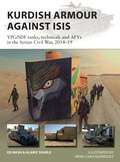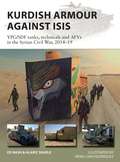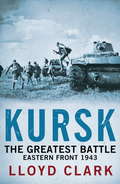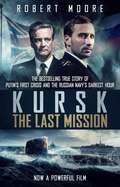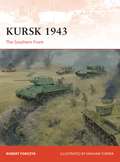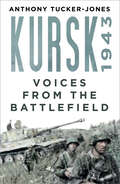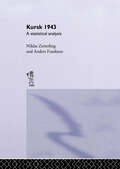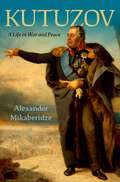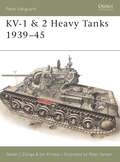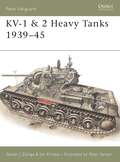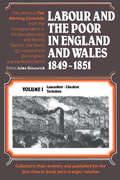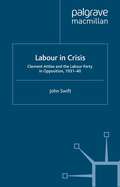- Table View
- List View
Kuraj (Andanzas Ser. #Vol. 513)
by Silvia Di NataleBorn in the late 1930s on the Central Asian steppe, Naja is the daughter of a clan chieftain of the Tushan nomads, proud descendants of Genghis Khan. When her fiercely independent father, U'lan, hears of Stalin's plan to bring the Tushan under state control and make them settle permanently in collective farms, he pledges to join forces with the invading German army. It is a pledge of honor that will take her father to the hell of Stalingrad and change Naja's life forever by eventually bringing her, at the age of nine, to ruined postwar Cologne. From there she must learn to adapt to a strange new culture, and to the strange family that has taken her in. But as Naja gradually grows more comfortable in this alien world, the memories of her young life on the steppe call out to her. She begins a difficult search for her past-and the past of her people-with only the word kuraj (Tushan for tumbleweed) as her talisman and guide. Silvia di Natale was born in Genoa in 1951 and moved to Germany in 1973, where she lives with her husband and son. She teaches and works as an ethnosociologist. Kuraj is her first novel. "An extraordinary epic of emigration, capture, ruin, flight and return-a revelation."-Corriere della Sera "Extraordinary and gripping."-Repubblica
Kurdish Armour Against ISIS: YPG/SDF tanks, technicals and AFVs in the Syrian Civil War, 2014–19 (New Vanguard)
by Alaric Searle Ed NashOne of the most remarkable mechanized campaigns of recent years pitted the brutal and heavily armed jihadis of Islamic State against an improvised force belonging to the Kurdish YPG (later the SDF). While some Kurdish vehicles were originally from Syrian Army stocks or captured from ISIS, many others were extraordinary homemade AFVs based on truck or digger mechanicals, or duskas, the Kurds' version of the technical. Before US air power was sent to Syria, these were the Kurds' most powerful and mobile weapons. Co-written by a British volunteer who fought with the Kurds and an academic expert on armoured warfare, this study explains how the Kurds built and used their AFVs in the war against 'Daesh', and identifies as far as possible which vehicles took part in major battles, such as Kobane, Manbij and Raqqa. With detailed new artwork depicting the Kurds' range of armour and many previously unpublished photos, this is an original and fascinating look at modern improvised mechanized warfare.
Kurdish Armour Against ISIS: YPG/SDF tanks, technicals and AFVs in the Syrian Civil War, 2014–19 (New Vanguard)
by Alaric Searle Ed NashOne of the most remarkable mechanized campaigns of recent years pitted the brutal and heavily armed jihadis of Islamic State against an improvised force belonging to the Kurdish YPG (later the SDF). While some Kurdish vehicles were originally from Syrian Army stocks or captured from ISIS, many others were extraordinary homemade AFVs based on truck or digger mechanicals, or duskas, the Kurds' version of the technical. Before US air power was sent to Syria, these were the Kurds' most powerful and mobile weapons. Co-written by a British volunteer who fought with the Kurds and an academic expert on armoured warfare, this study explains how the Kurds built and used their AFVs in the war against 'Daesh', and identifies as far as possible which vehicles took part in major battles, such as Kobane, Manbij and Raqqa. With detailed new artwork depicting the Kurds' range of armour and many previously unpublished photos, this is an original and fascinating look at modern improvised mechanized warfare.
The Kurdish Struggle, 1920-94
by E. O'BallanceForming minorities in five adjacent countries for 74 years, Kurds have been fighting for independence or autonomy, against governments reluctant to accede either. The Kurdish saga is one of periodic insurrections, partial victories, misfortunes, defeats, betrayal, national repression, clashing personalities, changing allegiances and an unusual mixture of heroism and expendiency. Kurds used governments, and governments used Kurds. A good insight is given into both political and military aspects of the struggle, and of the motives and machinations of major personalities involved.
Kursk: The Greatest Battle *special Sales*
by Lloyd Clark5th July 1943: the greatest land battle of all time began around the town of Kursk in Russia. This epic confrontation between German and Soviet forces was one of the most important military engagements in history and epitomised 'total war'.It was also one of the most bloody, characterised by hideous excess and outrageous atrocities. The battle concluded with Germany having incurred nearly three million dead and the Soviet Union a staggering ten million. It was a monumental and decisive encounter of breathtaking intensity which became a turning point, not only on the Eastern Front, but in the Second World War as a whole. Using the very latest available archival material including the testimonies of veterans and providing strategic perspective alongside personal stories of front line fighting, Lloyd Clark has written a lucid, enthralling and heart-stopping account of this incredible battle.
Kursk: The World's Greatest Tank Battle
by Rupert MatthewsThe Battle of Kursk was one of the most pivotal campaigns of World War II and Germany's final strategic offensive on the Eastern Front. Soviet armies had recently occupied the city of Kursk and the Germans aimed to pinch off the salient and cut off its supply chain. But Commander Erich von Manstein did not anticipate the Soviet's dramatic counter offensive, resulting in one of the bloodiest encounters of the Second World War which turned the tide against Adolf Hitler. Rupert Matthews narrates these dramatic events, outlining the strategic situation in 1943, the breakdown in Nazi chain of command and the circumstances of the Battle of Prokhorovka, one of the largest tank battles in military history. Also included are: • A play-by-play account of the battle, set within the context of surrounding conflict • Profiles of key characters, including German commander Erich von Manstein who led the offensive • Powerful photographs of the battle, as well as useful diagrams of the military manoeuvres The Battle of Kursk is a fascinating account of a major campaign that involved more than 3 million men, 8,000 tanks, 40,000 guns and 5,500 aircraft. The Soviets suffered extreme casualties, but their eventual victory left the road to Berlin open...
Kursk: A Time To Die
by Robert MooreAt 11.30 a.m. on Saturday 12 August 2000, two massive explosions roared through the shallow Arctic waters of the Barents Sea. The Kursk, pride of the Northern Fleet and the largest attack submarine in the world, was hurtling towards the ocean floor.In Kursk (originally published as A Time to Die), award-winning journalist Robert Moore vividly recreates this disaster minute by minute. Venturing into a covert world where the Cold War continues out of sight, Moore investigates the military and political background to the tragedy. But above all, he tells the nail-bitingly poignant human story of the families waiting ashore, of the desperate efforts of British, Norwegian and Russian rescuers, and of the Kursk sailors, trapped in the aft compartnemt, waiting for rescue, as a horrified world followed their battle to stay alive . . .
Kursk 1943: The Northern Front (Campaign #272)
by Robert Forczyk Steve NoonIn the summer of 1943, recoiling from defeat at Stalingrad, Hitler conducted a limited objective offensive to eliminate the Soviet Kursk salient. Operating a classic pincer attack of the kind that succeeded during the 1942 Kharkov campaign he hoped that the resulting heavy losses inflicted on the Red Army would give the Wehrmacht time to recover its strength. However, the Soviet anticipation of the attack led to extensive losses on both sides as Soviet anti-tank mines and fierce fighting pushed the Germans back, liberating the German-held Orel in the process. Focusing on the northern front of the battle with Generaloberst Walter Model's forces pitted against General Rokossovsky's Central Front between 5 July and 18 August, this volume will explore both the German offensive and the Soviet counteroffensive. Using documents from both sides, extensive photographs – both contemporary and modern, maps and bird's-eye-views this title will shed new light on this often ignored part of the battle.
Kursk 1943: The Northern Front (Campaign #272)
by Robert Forczyk Steve NoonIn the summer of 1943, recoiling from defeat at Stalingrad, Hitler conducted a limited objective offensive to eliminate the Soviet Kursk salient. Operating a classic pincer attack of the kind that succeeded during the 1942 Kharkov campaign he hoped that the resulting heavy losses inflicted on the Red Army would give the Wehrmacht time to recover its strength. However, the Soviet anticipation of the attack led to extensive losses on both sides as Soviet anti-tank mines and fierce fighting pushed the Germans back, liberating the German-held Orel in the process. Focusing on the northern front of the battle with Generaloberst Walter Model's forces pitted against General Rokossovsky's Central Front between 5 July and 18 August, this volume will explore both the German offensive and the Soviet counteroffensive. Using documents from both sides, extensive photographs – both contemporary and modern, maps and bird's-eye-views this title will shed new light on this often ignored part of the battle.
Kursk 1943: The Southern Front (Campaign)
by Robert Forczyk Graham TurnerMauled at Stalingrad, the German army looked to regain the initiative on the Eastern Front with a huge offensive launched near the city of Kursk, 280 miles south-west of Moscow. Armed with the new Panther tank, Hitler and Field Marshal von Manstein were confident that they could inflict another crushing defeat on the Soviet Union. What they did not know is that the Soviets knew about the coming attack, and they were ready. This book focuses on the southern front of this campaign, which featured one of the biggest clash of armour of the warin the battle of Prokhorovka which involved over a thousand tanks. It examines in detail the tactics and mistakes of the army commanders as they orchestrated one of the bloodiest battles in World War II. Using campaign maps, stunning photographs and vivid artwork, this new study, a companion to Campaign 272 Kursk 1943: The Northern Front, examines whether that the German offensive was doomed from the start as it takes the reader through this titanic clash of armour.
Kursk 1943: The Southern Front (Campaign #272)
by Robert Forczyk Graham TurnerMauled at Stalingrad, the German army looked to regain the initiative on the Eastern Front with a huge offensive launched near the city of Kursk, 280 miles south-west of Moscow. Armed with the new Panther tank, Hitler and Field Marshal von Manstein were confident that they could inflict another crushing defeat on the Soviet Union. What they did not know is that the Soviets knew about the coming attack, and they were ready. This book focuses on the southern front of this campaign, which featured one of the biggest clash of armour of the warin the battle of Prokhorovka which involved over a thousand tanks. It examines in detail the tactics and mistakes of the army commanders as they orchestrated one of the bloodiest battles in World War II. Using campaign maps, stunning photographs and vivid artwork, this new study, a companion to Campaign 272 Kursk 1943: The Northern Front, examines whether that the German offensive was doomed from the start as it takes the reader through this titanic clash of armour.
Kursk 1943: Hitler's Bitter Harvest
by Anthony Tucker-JonesIn 1943, as war raged along the Eastern Front, the German forces attempted to push further east in the brutal Operation Citadel, which saw one of the largest armoured clashes in history in the Battle of Prokhorovka. Countered by two Soviet attacks, this operation saw the tide turn on the Eastern Front. For the first time a German offensive was halted in its tracks and the Soviets ended the conflict as the decisive victors. With a loss of over 200,000 men on both sides, this two-month offensive was one of the costliest of the war. In this dramatic new study, Anthony Tucker-Jones reassesses this decisive tank battle through the eyes of those who fought, using recently translated first-person accounts. This is one volume that no military history enthusiast should be without.
Kursk 1943: A Statistical Analysis (Soviet (Russian) Study of War)
by Niklas Zetterling Anders FranksonThe battle at Kursk in 1943 is often referred to as the greatest tank battle in the history of warfare. This volume makes extensive use of German archival documents as well as various Russian books and articles. As well as an account of the battle, it addresses methodological issues.
Kursk 1943: A Statistical Analysis (Soviet (Russian) Study of War #Vol. 11)
by Niklas Zetterling Anders FranksonThe battle at Kursk in 1943 is often referred to as the greatest tank battle in the history of warfare. This volume makes extensive use of German archival documents as well as various Russian books and articles. As well as an account of the battle, it addresses methodological issues.
Kursk Down: The Shocking True Story of the Sinking of a Russian Nuclear Submarine
by Clyde BurlesonThe true story of the sinking of the Russian nuclear submarine in the Barents Sea on August 12, 2000. Hailed as "unsinkable, " the "Kursk" was on maneuvers when mysterious explosions rocked the sub, causing it to sink to the bottom of the sea with its 118-man crew. This in-depth look at the disaster reveals previously unreleased information from family members of the deceased as well as from government officials.
Kutuzov: A Life in War and Peace
by Alexander MikaberidzeA full-life portrait of the man Tolstoy immortalized, Stalin lionized, and Russian history has manipulated and mythologized beyond recognition. Every Russian knows him purely by his patronym. He was the general who triumphed over Napoleon's Grande Armée during the Patriotic War of 1812, not merely restoring national pride but securing national identity. Many Russians consider Field Marshal Mikhail Illarionovich Golenischev-Kutuzov the greatest figure of the 19th century, ahead of Pushkin, Tchaikovsky, even Tolstoy himself. Immediately after his death in 1813, Kutuzov's remains were hurried into the pantheon of heroes. Statues of him rose up across the Russian empire and later the Soviet Union. Over the course of decades and centuries he hardened into legend. As award-winning author Alexander Mikaberidze shows in this fascinating, often startling, and wholly humanizing new biography, Kutuzov's story is far more compelling and complex than the myths that have encased him. An unabashed imperialist who rose in the ranks through his victories over the Turks and the Poles, Kutuzov was also a realist and a skeptic about military power. When the Russians and their allies were routed by the French at Austerlitz he was openly appalled by the incompetence of leadership and the sheer waste of life. Over his long careermarked equally by victory and defeat, embrace and ostracismhe grew to despise those whose concept of war had devolved to mindless attack. Here, at last, is Kutuzov as he really wasa master and survivor of intrigue, moving in and out of royal favor, committed to the welfare of those under his command, and an innovative strategist. When, reluctantly and at the 11th hour, Czar Alexander I called upon him to lead the fight against Napoleon's invading army, Kutuzov accomplished what needed to be done not by a heroic charge but by a strategic retreat. Across the generations, portraits of Kutuzov have ranged from hagiography to dismissal, with Tolstoy's portrait of him in War and Peace perhaps the most indelible of all. This immersive biography returns a touchstone figure in Russian history to human scale.
Kutuzov: A Life in War and Peace (Campaign Chronicles Ser.)
by Alexander MikaberidzeA full-life portrait of the man Tolstoy immortalized, Stalin lionized, and Russian history has manipulated and mythologized beyond recognition. Every Russian knows him purely by his patronym. He was the general who triumphed over Napoleon's Grande Armée during the Patriotic War of 1812, not merely restoring national pride but securing national identity. Many Russians consider Field Marshal Mikhail Illarionovich Golenischev-Kutuzov the greatest figure of the 19th century, ahead of Pushkin, Tchaikovsky, even Tolstoy himself. Immediately after his death in 1813, Kutuzov's remains were hurried into the pantheon of heroes. Statues of him rose up across the Russian empire and later the Soviet Union. Over the course of decades and centuries he hardened into legend. As award-winning author Alexander Mikaberidze shows in this fascinating, often startling, and wholly humanizing new biography, Kutuzov's story is far more compelling and complex than the myths that have encased him. An unabashed imperialist who rose in the ranks through his victories over the Turks and the Poles, Kutuzov was also a realist and a skeptic about military power. When the Russians and their allies were routed by the French at Austerlitz he was openly appalled by the incompetence of leadership and the sheer waste of life. Over his long careermarked equally by victory and defeat, embrace and ostracismhe grew to despise those whose concept of war had devolved to mindless attack. Here, at last, is Kutuzov as he really wasa master and survivor of intrigue, moving in and out of royal favor, committed to the welfare of those under his command, and an innovative strategist. When, reluctantly and at the 11th hour, Czar Alexander I called upon him to lead the fight against Napoleon's invading army, Kutuzov accomplished what needed to be done not by a heroic charge but by a strategic retreat. Across the generations, portraits of Kutuzov have ranged from hagiography to dismissal, with Tolstoy's portrait of him in War and Peace perhaps the most indelible of all. This immersive biography returns a touchstone figure in Russian history to human scale.
KV-1 & 2 Heavy Tanks 1939–45 (New Vanguard)
by Steven J. Zaloga Peter SarsonNamed after Klimenti Voroshilov, the People's Commissar for Defence, the KVs proved a nasty surprise for German tank crews during the early days of Operation Barbarossa. Although slow, they were extremely heavily armoured. This volume examines the transition from multi-turreted tanks to heavy single-turret vehicles, consisting of the KV-1 and 2, and the increased favour given to the heavy single-turret after the Germans began to develop ammunition capable of penetrating even the thickest armour, whilst detailing the design, development and operational history of the Soviet Union's monstrous KV series of tanks.
KV-1 & 2 Heavy Tanks 1939–45 (New Vanguard #17)
by Steven J. Zaloga Peter SarsonNamed after Klimenti Voroshilov, the People's Commissar for Defence, the KVs proved a nasty surprise for German tank crews during the early days of Operation Barbarossa. Although slow, they were extremely heavily armoured. This volume examines the transition from multi-turreted tanks to heavy single-turret vehicles, consisting of the KV-1 and 2, and the increased favour given to the heavy single-turret after the Germans began to develop ammunition capable of penetrating even the thickest armour, whilst detailing the design, development and operational history of the Soviet Union's monstrous KV series of tanks.
Kyiv (Spoils of War #6)
by Graham HurleyThe gripping new thriller from Graham Hurley, KYIV is set against the backdrop of Operation Barbarossa, Hitler's all-consuming invasion of the Soviet Union.'Historical fiction of a high order' The Times 'Original and compelling... The fear enveloping Kyiv as the Soviets flee radiates from every page' Financial Times On Sunday 22nd June 1941 at 03.05, three-and-a-half million Axis troops burst into the Soviet Union along a 1,800-mile front to launch Operation Barbarossa. The southern thrust of the attack was aimed at the Caucasus and the oil fields beyond. Kyiv was the biggest city to stand in their way.Within six weeks, the city was under siege. Surrounded by Panzers, bombed and shelled day and night, Soviet Commissar Nikita Khrushchev was amongst the senior Soviet officials co-ordinating the defence. Amid his cadre of trusted personnel is British defector Bella Menzies, once with MI5, now with the NKVD, the Soviet secret police.With the fall of the city inevitable, the Soviets plan a bloody war of terror that will extort a higher toll on the city's inhabitants than the invaders. As the noose tightens, Bella finds herself trapped, hunted by both the Russians and the Germans.As the local saying has it: life is dangerous – no one survives it.Kyiv is part of the SPOILS OF WAR Collection, a thrilling, beguiling blend of fact and fiction born of some of the most tragic, suspenseful, and action-packed events of World War II. From the mind of highly acclaimed thriller author GRAHAM HURLEY, this blockbuster non-chronological collection allows the reader to explore Hurley's masterful storytelling in any order, with compelling recurring characters whose fragmented lives mirror the war that shattered the globe.'You could read a lot of books before you found a tale better told' The Times 'This is a masterful novel: a war narrative, a spy thriller, and a historical fiction steeped in meticulously-researched factual detail' Dr Christine Berberich, University of Portsmouth
La-5/7 vs Fw 190: Eastern Front 1942–45 (Duel)
by Jim Laurier Dmitriy Khazanov Andrey Yurgenson Gareth Hector Aleksander MedvedSoviet fighter aviation suffered terribly at the hands of the Jagdwaffe in the first year of the war in the east and, with the arrival of JG 51 and its Fw 190s on the Stalingrad Front in September 1942, things only got worse. However, help was on its way in the form of the La-5. Tougher, faster, and with a greater rate of climb than its predecessors, most were flow by a new generation of better-trained pilots led by combat veterans. These new fighters soon found themselves pitted into action on the Central Sector against the equally new Fw 190As of JG 51. From then on, these two fighters would battle it out in the skies over the Eastern Front. This book tells the complete story of the battles between these two important fighters.
La-5/7 vs Fw 190: Eastern Front 1942–45 (Duel #39)
by Jim Laurier Dmitriy Khazanov Andrey Yurgenson Gareth Hector Aleksander MedvedSoviet fighter aviation suffered terribly at the hands of the Jagdwaffe in the first year of the war in the east and, with the arrival of JG 51 and its Fw 190s on the Stalingrad Front in September 1942, things only got worse. However, help was on its way in the form of the La-5. Tougher, faster, and with a greater rate of climb than its predecessors, most were flow by a new generation of better-trained pilots led by combat veterans. These new fighters soon found themselves pitted into action on the Central Sector against the equally new Fw 190As of JG 51. From then on, these two fighters would battle it out in the skies over the Eastern Front. This book tells the complete story of the battles between these two important fighters.
Labour and the Poor in England and Wales, 1849-1851: Lancashire, Cheshire & Yorkshire
by Jules GinswickFirst Published in 1983. In October 1849 a London newspaper, the Morning Chronicle, announced to its middle-class readers that it was to undertake a survey of the condition of the labouring classes in England and Wales under the general title of “Labour and the Poor”. The reports of the survey were published over a period of two years and provided the mid-nineteenth-century Englishman with the most comprehensive view of the working classes that he had ever seen. The letters to The Morning Chronicle from the manufacturing, mining and rural districts and the towns of Liverpool and Birmingham appear here for the first time in book form and have been organised in eight volumes. This is Volume I and offer insights into labour and the poor in England and Wales 1849 to 1851 in the areas of Lancashire, Cheshire and Yorkshire.
Labour and the Poor in England and Wales, 1849-1851: Lancashire, Cheshire & Yorkshire
by Jules GinswickFirst Published in 1983. In October 1849 a London newspaper, the Morning Chronicle, announced to its middle-class readers that it was to undertake a survey of the condition of the labouring classes in England and Wales under the general title of “Labour and the Poor”. The reports of the survey were published over a period of two years and provided the mid-nineteenth-century Englishman with the most comprehensive view of the working classes that he had ever seen. The letters to The Morning Chronicle from the manufacturing, mining and rural districts and the towns of Liverpool and Birmingham appear here for the first time in book form and have been organised in eight volumes. This is Volume I and offer insights into labour and the poor in England and Wales 1849 to 1851 in the areas of Lancashire, Cheshire and Yorkshire.
Labour in Crisis: Clement Attlee and the Labour Party in Opposition, 1931-40
by J. SwiftThis is a study of the development of Clement Attlee and the Labour Party from the collapse of the second Labour Government in August 1931, to their entry into Churchill's coalition in May 1940. It is an examination of how Labour, from being driven from office as unfit to govern, recovered to be seen as essential to the effective prosecution of the war, and how Attlee emerged from relative obscurity to become a central figure in the War Cabinet.

